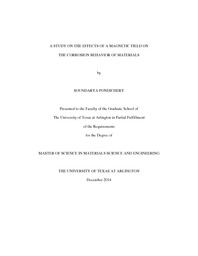
ATTENTION: The works hosted here are being migrated to a new repository that will consolidate resources, improve discoverability, and better show UTA's research impact on the global community. We will update authors as the migration progresses. Please see MavMatrix for more information.
Show simple item record
| dc.contributor.author | Pondichery, Soundarya | en_US |
| dc.date.accessioned | 2015-07-01T17:50:38Z | |
| dc.date.available | 2015-07-01T17:50:38Z | |
| dc.date.issued | 2014 | |
| dc.date.submitted | January 2014 | en_US |
| dc.identifier.other | DISS-12979 | en_US |
| dc.identifier.uri | http://hdl.handle.net/10106/24980 | |
| dc.description.abstract | Corrosion causes deterioration of a material due to its environment. Corrosion control has been one of the biggest challenges in most industries since many years. There are various notable and unknown factors that influence the rate of corrosion of a certain material/environment system. Magnetic fields and their driven effects on an electrochemical system has been recently gained interest. Various magnetic field driven forces occurring in an electrolyte have been reported during an electrochemical reaction. Lorentz force driven convection in the electrolyte, known as MHD effect and paramagnetic gradient forces are reported to be the most effective. This research studies the effects of an external magnetic field on the electrochemical nature of materials in 3.5% NaCl solution. To understand and analyze magnetic field effects on a wide range of materials, both ferromagnetic and non-magnetic materials which are active, active-passive type are studied in near sea water solution i.e. 3.5% NaCl solution. Potentiodynamic polarization and corrosion potential vs time tests were carried out to study and analyze corrosion behavior in 3.5% NaCl solution. Corrosion tests results were obtained both with and without the influence of an external magnetic field of 0.75T. On comparing the electrochemical analysis results of both conditions in 3.5% NaCl solution, it clearly depicts the effect of an external magnetic field on the corrosion potential and corrosion rate. In the case of ferromagnetic materials like 416 SS and 1018 carbon steel, a cathodic shift of the corrosion potential and increase in the corrosion rate was observed. While for ferrous but non-magnetic and passivating material like 304 SS, no effect of the magnetic field was observed which can be attributed to its non-magnetic austenitic phase and highly stable oxide formation tendency. Also, no effect was observed on the non-ferrous alloys like Ti alloy (Ti6Al4V) and Zn due to not only because of diamagnetic nature of its ions but also of its actively passivating and dissolution nature respectively. On comparing the SEM micrographs taken post each experiment to study the surface morphology, it confirmed the increased corrosion activity on 416 SS and 1018 carbon steel and no effect on 304 SS, Ti and Zn. | en_US |
| dc.description.sponsorship | Meletis, Efstathios | en_US |
| dc.language.iso | en | en_US |
| dc.publisher | Materials Science & Engineering | en_US |
| dc.title | A Study On The Effect Of Magnetic Field On The Corrosion Behavior Of Materials | en_US |
| dc.type | M.S. | en_US |
| dc.contributor.committeeChair | Meletis, Efstathios | en_US |
| dc.degree.department | Materials Science & Engineering | en_US |
| dc.degree.discipline | Materials Science & Engineering | en_US |
| dc.degree.grantor | University of Texas at Arlington | en_US |
| dc.degree.level | masters | en_US |
| dc.degree.name | M.S. | en_US |
Files in this item
- Name:
- Pondichery_uta_2502M_12979.pdf
- Size:
- 3.490Mb
- Format:
- PDF
This item appears in the following Collection(s)
Show simple item record


